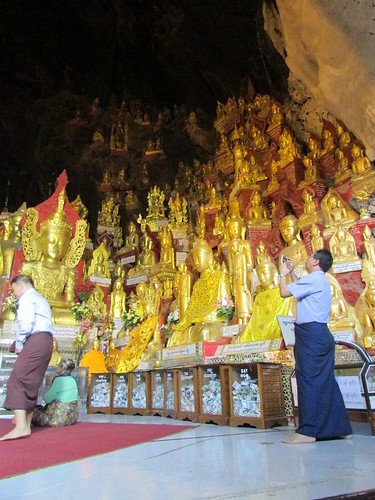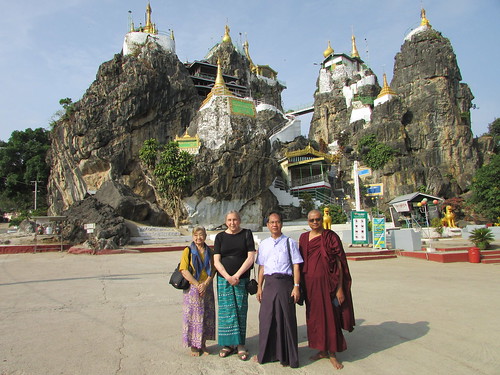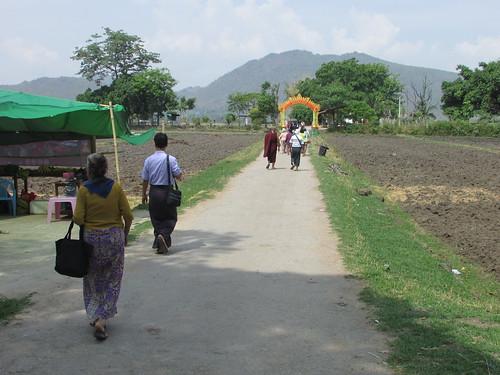skip to main |
skip to sidebar
Wednesday, 15th May 2019
I slept well at the Hotel Myat Nan Taw and enjoyed breakfast with my friends in the restaurant. In Myanmar, accommodation is often on a bed-and-breakfast basis and, in built-up areas like Taung Gyi, hotels are often five stories tall or more with the restaurant on the top floor. Our Hotel followed this layout and, with my room on the same floor, this was convenient provided the lift continued to work (which it did but with an ominous throbbing for much of the time suggesting that we were running from a standby generator, rather than mains). Both my room and the restaurant provided interesting views of the rather modern city whose population is well over 400,000.

View of Taung Gyi from my hotel room.
After breakfast, we set off by car, travelling east through Hopong to our first visit of the day which, I discovered, was to be another natural cave pagoda, this time Myittar Kham Tan Caves, known as Hathtipala Dhammacakka - 'the light of Buddha's Sasana cave' (although Google Maps show it as Htem Sann Cave). This was clearly an important pilgrimage site and there were lots of Myanmar visitors. At many of the more important religious sites, foreign visitors are required to pay an admission fee and the charge here for me was 20 U.S. Dollars.

The entrance to Myittar Kham Tan Caves.
Once inside the caves, it was cool and quite wet but a decent tiled floor had been provided and we made our way through a series of huge caverns, some well over 30 feet in height with fantastic rock effects hanging above us, some cone-like stalactites, others vertical sheets of rock.

Inside Myittar Kham Tan Caves.
We walked past numerous gilded Buddha images before pausing for the compulsory 'group picture'.

Our Group inside Myittar Kham Tan Caves.
Emerging from the cave complex, Doctor Hla Tun pointed out the large, covered eating area where free meals are available to pilgrims throughout the day, provided by the Abbott responsible for the caves.

Myittar Kham Tan Caves - distribution of Free Lunch.
The popularity of Myittar Kham Tan Caves was made clear by the long row of vendors offering food and gifts to the pilgrims. The Doctor purchased strawberries which were later turned into 'strawberry smoothies'.

Myittar Kham Tan Caves - area for vendors.
We re-traced our route to Taung Gyi, stopping to visit the modern pagoda whose design is based on the Ananda Pagoda at Bagan.

Taung Gyi modern pagoda (design based on the Ananda Pagoda at Bagan)
Internally, the circulating passages with rows of niches mimicked the appearance of the Ananda Pagoda.

Taung Gyi modern pagoda
Electricians were installing plastic trunking in the circulating passages and, as I passed, they were testing a long string of LED lights prior to installation. The urge to adorn pagodas with all sorts of lighting effects seems irresistible to Myanmar people.

Electricians testing LED lighting prior to installation: Taung Gyi modern pagoda.
Near our hotel, we stopped at a suitable tea shop to take lunch, before checking out from the hotel finally.

The Monk and our driver take lunch in Taung Gyi
It was a few minutes before all formalities has been completed so, waiting at the entrance to our hotel, I became fascinated watching the operation of a small drilling rig in use at the hotel immediately opposite. The objective appeared to be to drill a vertical hole, two or three inches diameter and perhaps a few feet deep in the concrete outside the other hotel but I couldn't discern for what purpose.

Drilling a Hole, Taung Gyi
We left Taung Gyi and this time headed west, passing through Shwe Naung and continuing to Heho, where we turned right onto a minor road heading north. For a time, I could see the control tower at Heho Airport, from where I've flown a number of times. Then the country roads were unfamiliar to me.
Eventually. we emerged at the main road from Kalaw to Lawksawk at the town of Pindaya. West of the town, situated on a limestone ridge, we arrived at the Pindaya Caves. There's a Wikipedia article about these famous caves here. The caves are approached by a rising road flanked by vendors' shops. Originally, it was necessary to climb one of the flights of covered steps to reach the actual cave entrance, high on the cliff face but two massive electric elevators now take visitors without effort.

Approach to Pindaya Caves (Shwe Oo Min Natural Cave Pagoda).
A rather odd-looking giant spider faces visitors as you approach the elevators. This is a representation of a legend that seven princesses bathing in a lake were captured and held the cave by a spider until released by Prince Kummabhaya of Yawnghwe.

Approach to Pindaya Caves (Shwe Oo Min Natural Cave Pagoda). The old legend is represented by the Prince (left, with bow), spider and (behind) seven princesses.
On leaving the elevator, splendid views of the surrounding area are provided.

Pindaya and Pone Taloke Lake, viewed from Pindaya Caves Elevators.
Whereas Myittar Kham Tan Caves had been spacious allowing the geology of the caves to be studied, by contrast, every available space within Pindaya Caves is filled with gilded Buddha images, with only narrow passageways and cramped steps allowing pilgrims to move around. The effect is impressive, if somewhat claustrophobic.




Shwe Oo Min Natural Cave Pagoda

Our group at Pindaya Caves.
Incidentally, back in 2016 I visited a cave pagoda in Kalaw which I believe also shares the name 'Shwe Oo Min'. My pictures of the Kalaw cave pagoda are in the album here.
We then set off south on Highway 41 to cover the 50 kilometres through Aungban to Kalaw. We made one stop in the hills above Kalaw at a Sunrise/Sunset Viewpoint but visibility was not very good. A group of young people were amusing themselves by letting off small rockets. This appeared to be particularly hazardous as the small firework charge came without a 'stick' which the user had to supply and tie to the firework before launch! Although these fireworks were for entertainment, the Doctor explained that, traditionally, fireworks were let off to induce rain. Perhaps it works because that night it rained.

Sunset at a viewpoint overlooking Kalaw.
In Kalaw the Doctor arranged accommodation at the Ramonar Hotel which is situated in the hills above Kalaw and constructed as a series of semi-detached villas. As usual, after the exertions of the day, I was keen to retire to my room and collapse. When it was realised that my room had no air conditioning, it was suggested that I might prefer to re-locate to a room with that facility but I guessed (fortunately correctly) that in Kalaw I'd be comfortable without A/C so stayed where I was.
Related posts on this website
This is one of a series of posts describing my 14th visit to Myanmar. The post Return to Burma is the first post in the series.
Clicking on the 'Next report' link displays the post describing the next events. In this way, you may read about the trip in sequence.
Next report.
Alternately, clicking on the 'All my Burma 2019 reports' link displays all the posts on this trip in reverse date-of-posting order.
All my Burma 2019 reports.
My pictures
Burma 2019.
Taung Gyi, 2019.
Myittar Kham Tan Caves.
Pindaya Caves (Shwe Oo Min Natural Cave Pagoda).
All my pictures on this trip are in the collection Burma 2019.
Tuesday, 14th May 2019
Despite the title of this post, we spent Monday night and much of Tuesday in Myanmar's smallest state, Kayah, before re-entering Shan State. A good sleep at the Thingaha Hotel in Loikaw left me restored on Tuesday morning. I didn't appreciate the hotel's charming location until I met my companions for breakfast. Although within a few hundred yards of the main features of Loikaw, the hotel is situated on a quiet stretch of the northern bank of the Balu Chaung River and the open-sided pavilion on the terrace where breakfast was served overlooked the river. Both the proprietor and his wife made a point of personally welcoming me to their hotel.
I'd enjoyed a brief visit to Kayah State previously in 2017 (reports here).
After breakfast, our first visit was to Taung Gwe Zedi, the improbable group of pagodas built on a series of rock pinnacles overlooking the city. I'm afraid that, on this visit, I was content to use the elevator both to ascend and return to ground level.

Visiting Taung Gwe Zedi, Loikaw (Burma 2019).

The 'group shot' Taung Gwe Zedi
We drove south out of Loikaw, passing the display of strange white-painted Kutopoe Pillars I'd first seen two years earlier. Although Buddhism and Christianity are both widely practiced in Kayah State, I'd learned that Animism still exists and the Kutopoe Pillars form part of this tradition. There's an album of pictures of the Loikaw Kutopoe Pillars, taken in 2017, here.

Kutopoe Pillars, Loikaw (Burma 2019)
We continued on Highway 5 (which eventually leads to Taungoo, in Bago Region) for about twelve kilometres, pausing at Ngwe Taung lake and dam which supplies water for irrigation.

Ngwe Taung lake and dam, Kayah State (Burma 2019)
Two elephants were attracting a lot of interest and rides were being offered on the older elephant, in a simple 'howdah'. These were almost certainly the same pair I'd seen two years previously. After the compulsory 'group picture' we toured nearby Ngwe Taung Market. The Doctor's mother is a discerning and determined market shopper.

Our group at Ngwe Taung lake and dam, Kayah State (Burma 2019)

Shopping at Ngwe Taung Market, Kayah State (Burma 2019)
Returning to Loikaw, we checked out of the Thingaha Hotel and drove through Loikaw selecting a suitable tea shop for lunch. The Doctor is always careful in his choice of tea shops, understanding that any 'Western' digestion (not just mine) is far more easily upset by typical kitchen hygeine practices in Myanmar than a resident's would be.

Typical Kitchen of a Loikaw Teashop (Burma 2019)

View of Balu Chaung River from the Loikaw tea shop where we took lunch (Burma 2019)
After lunch, we headed out of Loikaw again to a country area south-east of Ngwe Taung where Seven Steps Lake is located. This is a series of lakes interconnected by streams and it is a favourite destination for Myanmar people. In 2017, I'd visited Seven Steps Lake in a rainstorm and that visit is described in the post here.

Seven Steps Lake
Not too far way, we reached the intriguing Umbrella lake where venting gas from geothermal activity periodically lifts the mud of a small lake into one (or sometimes more) visible domes thought to resemble umbrellas. This is another location I'd visited in 2017, described here. On that trip, I took a picture of an archway being built on the approach to Umbrella Lake. In 2019, that archway appeared to have been dismantled but an impressive, painted archway had been completed near the lake.

The approach to Umbrella Lake in 2017.

The approach to Umbrella Lake in 2019.

Our group at Umbrella Lake.
We returned to Loikaw where we visited a tourist initiative called a 'Kayan Traditional Village' - a large area of beaten earth with two rows of stalls made of bamboo and thatched. There were a number of the traditional Long-Necked Padaung women (and children) manning the various stalls, plus additional heavy, brass neck rings, carefully sliced in two and provided with tapes to allow visitors to create their own 'Long-Neck' pictures. I had visited the Padaung village of Pan-Pet in 2017 (report here), so I'll not re-iterate my distaste regarding the Long-Neck tradition which I believe is tending to die out.
Perhaps unsurprisingly, male Padaung fashion involves no heavy or permanent adaptations and our driver was happy to appear in male traditional attire.

Our driver in traditional dress at the Kayan Craft Village.
We then left Loikaw for the last time, heading north on the NH5. At the junction with the road from Phe Khong (the road we'd arrived by the previous day), we stayed on the NH5, heading north on the road which would eventually lead to Taung Gyi. We turned right off this road to reach a well-known series of waterfalls and place of pilgrimage, a beautiful spot which remained tranquil despite quite a few visitors from Myanmar.

The Waterfalls.
The various falls were interconnected by ornamental bridges, there were bathing places and inflated lorry inner tubes could be hired for young people to swim.

Burma 2019: Waterfalls showing swimming place with inflated lorry tyres.
There was also a large shrine with a huge gong outside which I was told commemorated the deaths of a large number of soldiers but I'm afraid I didn't get the details.

Burma 2019: Waterfalls, showing main shrine and huge gong.
We re-traced our route to the main road after a fascinating visit to the waterfalls and continued north, re-entering Shan State and passing through Hsihseng. After pausing at a tea shop in Loisawn for a cup of hot, sweet tea, we turned left onto the minor road which would take us to Kakku with its 2,478 Myanmar-style pagodas.
I first visited Kakku during my second visit to Myanmar in September, 2008, described here, not long after foreign tourists had been allowed to travel to what were still called 'The Long-lost pagodas of Kakku'. I thought the area very special then, as I did on my second visit in 2017 (described here), when I was able to watch a ceremony dedicating replacement 'Hti'. The 'Hti' is the delicate metal 'umbrella' which crowns the tapering spire of the pagoda. By the time we arrived at Kakku for my third visit, the sky had turned dark and the late afternoon sun produced dramatic lighting effects so that I was no less impressed than on my earlier visits.

Kakku Pagodas, Shan State.
There is one large, modern pagoda at which my friends paid their respects. Internally, there are four decorated niches with Buddha images. I was fascinated watching three work people (two men, one woman) re-gilding one of the niches.

Burma 2019: Re-gilding one of the four niches with Buddha images at the large, modern pagoda at Kakku.
I still enjoy wandering through the serried ranks of small pagodas at Kakku, with their stucco now a kaleidoscopic array of colours - various browns, white, pink - as the damage of centuries has been repaired by donors.

Burma 2019: Rows of pagodas at Kakku, Shan State.
But after a long and fairly active day, with the weather still hot compared with what I'm used to, I was tiring. We still had a drive of 46 kilometres to reach Taung Gyi, the Shan state capital, where we stayed the night. It took a little while for the Doctor to select suitable accommodation but his final choice, the Hotel Myat Nan Taw was excellent.
Related posts on this website
This is one of a series of posts describing my 14th visit to Myanmar. The post Return to Burma is the first post in the series.
Clicking on the 'Next report' link displays the post describing the next events. In this way, you may read about the trip in sequence.
Next report.
Alternately, clicking on the 'All my Burma 2019 reports' link displays all the posts on this trip in reverse date-of-posting order.
All my Burma 2019 reports.
My pictures
I've uploaded lots of pictures to 'Flickr' but they're not all sorted and titled. I'll get onto it as soon as I can.
Burma 2019
[Pictures added 17-May-2019: Edits and pictures embedded 6-Jun-2019: Further edits, pictures added 14/15-Jun-2019]







































